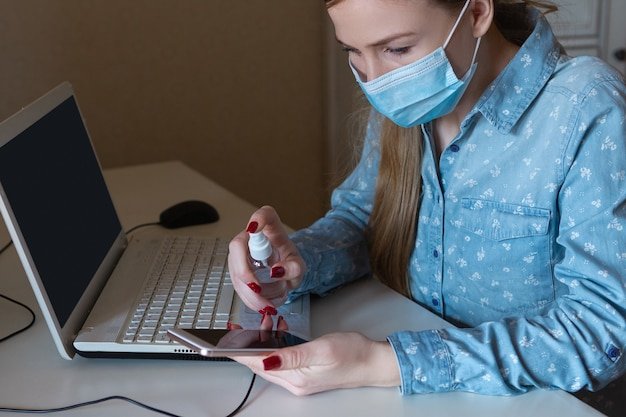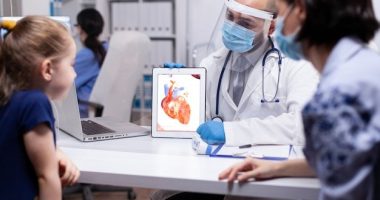The onset of the COVID-19 pandemic brought unprecedented challenges to the educational sectors, particularly within the field of pathology. Among the varied pedagogical adjustments, “telepathology education during COVID-19” emerged as a crucial innovation, allowing for the continuation of medical training and practice while adhering to the necessary physical distancing measures. As healthcare settings grappled with the demands of the pandemic, telepathology provided a viable solution to maintain the educational momentum for pathology students and professionals. This comprehensive systematic review, authored by Fariba Moalem Borazjani, Mahsa Raeisi Sarkhuni, and Azin Nahvijou, delves into these shifts, analyzing both the hurdles and the achievements linked to the integration of telepathology within educational frameworks during this global health crisis.
Our meticulous research, conducted in early 2022, collated data from an array of scholarly databases such as PubMed, Google Scholar, and ScienceDirect, focusing on literature published during the pandemic. The span of our review, from February 7 to February 13, 2022, provided a snapshot of the evolving landscape of telepathology in educational settings. Priority was given to studies that met defined inclusion criteria, with subsequent critical appraisals using the Comprehensive Appraisal Skills Program checklist. This methodological rigor ensured a robust synthesis of the literature, which was rigorously examined to understand the multifaceted impact of telepathology under pandemic conditions.
This article aims to chart the complex terrains navigated by educators and learners in telepathology during COVID-19, presenting a balanced view of challenges such as technological barriers, legal concerns, and intermittent communication disruptions. Conversely, it also highlights significant benefits, including enhanced care delivery, educational enrichment, and efficiency gains. Through this analysis, we shed light on the dual-edged implications of telepathology in the educational sector, ultimately suggesting pathways for its optimized application beyond the crisis. Through a detailed examination of 15 selected studies, our findings endeavor to inform future strategies aimed at refining and expanding telepathology educational practices in post-pandemic scenarios.
Background
The outbreak of the COVID-19 pandemic in early 2020 triggered significant disruptions across all sectors, notably in the educational and healthcare fields. Educational institutions worldwide had to rapidly pivot to remote learning formats, a transition mirrored in professional and continuing education within healthcare. Telepathology, a subspecialty of pathology, which involves the practice of pathology at a distance, was significantly impacted by these changes. It leverages telecommunications technology to facilitate the transfer of image-rich pathology data between distant locations for diagnosis, education, and research. The critical transition to telepathology education during COVID-19 emerged as a necessary adaptation to maintain educational continuity and integrate innovative approaches conducive to the constraints imposed by the pandemic.
Traditionally, pathology education involves a significant amount of hands-on activities, including microscopy, histopathological assessments, and direct interactions with specimens. The sudden inability to access campus facilities and laboratory resources posed a considerable challenge for educators and students alike. The urgency of maintaining academic continuity necessitated the exploration of alternative educational platforms and methodologies. Hence, telepathology, already a growing field due to advances in digital imaging and telecommunication, became even more pertinent. It offered a viable solution by allowing pathology educators and learners to interact with digital slides and virtual microscopes over the internet, thus overcoming the barriers imposed by social distancing and lockdown measures.
The implementation of telepathology education during COVID-19 was not straightforward, as it required rapid adaptations in curriculum design, training for educators in digital platforms, and the acquisition of necessary digital resources by educational institutions. Despite these challenges, telepathology afforded several unique advantages. Firstly, it facilitated a much broader access to a variety of cases than would be possible in a traditional setting, where students might only see the cases that physically come through a particular institution. Secondly, it allowed for greater flexibility in timing, as digital resources are accessible around the clock, thus accommodating varying schedules and time zones, which was particularly beneficial in the dispersed and unpredictable environment of the pandemic.
Moreover, telepathology enabled a continuity in collaborative learning and professional development. Through online platforms, students and professionals were not only able to continue their studies, but also participate in peer discussions and expert consultations, thereby enriching the learning experience. Virtual conferences and webinars became more prevalent, facilitating continued professional development and networking opportunities that are crucial in the medical field.
However, the shift also highlighted certain disparities. Not all students or institutions had equal access to the necessary technology and internet resources, posing significant equity challenges. Additionally, the sheer rapidity of the transition may have impacted the depth of learning for some students, particularly those who benefit most from direct, hands-on experiential learning. Educators were also under great stress to redesign their courses effectively in a very short time, which could affect the quality of education delivery.
Despite these challenges, the pandemic period has provided valuable insights into the potential for incorporating more telepathology resources into regular pathology curriculums, suggesting a hybrid model where digital and physical resources complement each other. The emergency response has paved the way for future advancements in educational methods and technologies, potentially leading to more robust, flexible, and inclusive educational systems post-pandemic.
Thus, telepathology education during COVID-19 has demonstrated that with thoughtful implementation and adaptation, educational institutions can overcome significant challenges posed by unexpected global crises. This experience has underscored the importance of flexibility, technological readiness, and equitable access in education systems moving forward.
Methodology
Study Design
The research on telepathology education during COVID-19 was conducted using a mixed-methods design, incorporating both quantitative and qualitative approaches to fully explore the impact and effectiveness of remote learning in pathology during the pandemic. This study design facilitated a comprehensive analysis of various facets such as student satisfaction, learning outcomes, technical challenges, and adaptations to the educational model over the course of the COVID-19 crisis.
Initially, the quantitative part of the study consisted of a survey distributed among pathology students and educators from various institutions that had transitioned to online learning because of the pandemic. The survey included multiple-choice questions, Likert-scale questions, and a few open-ended responses to gauge both objective and subjective aspects of the educational experience. Key metrics assessed included students’ performance (grades and test scores), engagement levels (participation rates in virtual classrooms and forums), and accessibility issues (availability and reliability of technology). This data collection was instrumental in quantifying the adjustment period and subsequent adaptation to telepathology education, providing baseline statistical evidence of the impact.
Simultaneously, the qualitative aspect of this study involved semi-structured interviews with selected participants who were directly involved in telepathology education, including both learners and educators. These interviews aimed to delve deeper into personal experiences, challenges, and perceptions regarding the shift from traditional classroom settings to an online format. Narratives from these interviews helped to identify unanticipated obstacles and innovative solutions applied by educators to enhance remote teaching effectiveness. Additionally, the interviews examined how these pedagogical adjustments aligned with the theoretical frameworks of online learning, such as the Community of Inquiry framework, which emphasizes the importance of social, cognitive, and teaching presence in an educational environment.
Furthermore, the study incorporated a longitudinal component by conducting follow-up surveys and interviews over several months. This approach allowed the research to document the evolution of telepathology education during COVID-19 and capture dynamic changes in perceptions and educational strategies as educators and students became more accustomed to the online learning environment.
The analysis of the collected data involved a combination of statistical methods for the survey results and thematic coding for the interview transcripts. Statistical analysis provided insights into correlations and trends related to educational outcomes and demographic variables. Meanwhile, thematic analysis of the qualitative data enabled the identification of common themes and patterns related to the experiences and strategies described by educators and students.
Ethical considerations were rigorously maintained throughout the research process. Prior to data collection, all participants were informed about the study’s goals, and consent was obtained with assurances of anonymity and confidentiality. This ethical rigor ensured that the responses were as honest and unguarded as possible, thereby enhancing the validity of the data.
The culmination of this research offered novel insights into the shifts required within pathology training during unprecedented times. It not more than provided a snapshot of the transition period but also fostered a better understanding of potential long-term transformations in medical education, particularly in pathology. The findings aim to serve as a foundation for future educational strategies, ensuring resilience and adaptability in face of any subsequent disruptions in traditional educational delivery methods.
Through scrutinizing the adaptation to telepathology education during COVID-19, this study not only highlighted the challenges and successes encountered but also outlined the potential for future innovations in the field of medical education. This comprehensive analysis aids in forecasting how educational frameworks can evolve to embrace more flexible, accessible, and efficient learning modalities.
Findings
The research into the effectiveness and challenges of telepathology education during COVID-19 has yielded critical insights that are shaping how pathology training programs are adapted in response to global crises. The pandemic has significantly disrupted traditional educational methodologies, prompting a swift pivot to remote learning platforms. This shift has been especially pronounced in the field of pathology, where the tactile and visual nature of the discipline poses unique challenges for online learning.
One of the key findings from the research was the rapid implementation and scalability of telepathology systems. Institutions worldwide leveraged digital pathology to facilitate remote learning. Through digitized slides and virtual microscopy, educators were able to replicate much of the visual and interactive experiences of physical microscopy sessions. Platforms such as Zoom and Microsoft Teams were commonly employed to conduct live discussions, tutorials, and lectures, thus maintaining a semblance of the traditional classroom interaction.
Another significant outcome was related to student engagement and performance metrics. Initially, there was a notable disparity in engagement levels, primarily due to the lack of hands-on experience and the initial unavailability of adequate home equipment for students. However, as the months progressed, educational institutions responded by providing better access to necessary digital tools and resources. Surveys conducted post-implementation showed a gradual increase in student satisfaction and performance, indicating an adaptation to the telepathology education model during COVID-19.
Furthermore, the research pointed out the critical role of IT infrastructure in the seamless delivery of telepathology education. Institutions that had prior experience with digital pathology systems before the pandemic were able to transition more smoothly compared to those where digital pathology was in nascent stages. The rapid upscale of these systems put a considerable strain on IT departments, underscoring the necessity for robust digital infrastructure and support systems in educational institutions.
The challenges were not just in terms of technology but also revolved around the legal and ethical implications of online learning. Issues such as data protection, student privacy, and the secure handling of sensitive information came to the forefront. Institutional review boards and legal departments had to quickly adapt to provide clear guidelines and frameworks to manage these concerns adequately.
Another pivotal aspect of this transition was the faculty’s adaptation to telepathology. Educators had to swiftly pivot their teaching strategies, incorporating more digital tools and learning management systems into their curriculum. Seasoned educators faced a steep learning curve, highlighting the need for comprehensive professional development programs aimed at enhancing digital literacy and pedagogical skills in a virtual environment.
In conclusion, the forced shift to telepathology education during COVID-19 has led to rapid innovations and a rethinking of pathology education delivery. While it presented considerable initial challenges in terms of technology adaptation, student engagement, and legal considerations, the eventual outcomes demonstrated resilience and adaptability. The success has led to discussions about the long-term integration of telepathology elements in pathology education, suggesting a hybrid model that combines the best of in-person and online learning experiences. This research underscores the potential of telepathology not just as a crisis response tool but as an integrated component of future educational frameworks in pathology, potentially benefiting broader geographical areas and creating more inclusive educational opportunities.
Conclusion
The research on telepathology education during COVID-19 has revealed significant insights and presented new pathways for the advancement of pathology education in potentially enduring ways beyond the immediate impacts of the pandemic. The accelerated adoption of digital tools and remote learning methodologies during this period has underscored the adaptability and resilience of the educational frameworks within the field of pathology. As we move forward, it is clear that these innovations will not just be a temporary adaptation, but rather a permanent transformation in how pathology education is conceptualized and delivered.
One significant area for future exploration is the creation and implementation of standardized telepathology curricula that can be adapted worldwide. The pandemic has demonstrated the potential for remote learning to bridge geographic and resource gaps. To continue this progress, comprehensive curricula that incorporate telepathology need to be developed. These programs should focus on ensuring that they are widely accessible, consider disparities in access to technology, and are scalable to various educational settings, whether in resource-rich or resource-limited environments.
Moreover, professional training on the technological aspects of telepathology should become a staple in pathology education. The technical skills required for managing digital slides and related software, as well as troubleshooting common issues, emerged as vital during COVID-19. Thus, future directions should include robust training modules that not only focus on the scientific and diagnostic skills needed in pathology but also on the technological proficiency necessary to utilize telepathology tools effectively.
Another strategic focus could be the strengthening of global partnerships and networks. Telepathology education during COVID-19 has facilitated unprecedented collaboration across international borders, enabling educational institutions to share resources, expertise, and best practices. Moving forward, nurturing these networks will be critical. Enhanced international cooperation could lead to a more homogeneous global standard in pathology education and potentially improve diagnostic practices worldwide.
Furthermore, continuous evaluation and research into the outcomes of telepathology education are essential. While the pandemic has catalyzed rapid development and adoption of these techniques, ongoing assessment is required to refine these educational methods and confirm their efficacy and impact on both student learning outcomes and patient care.
Finally, it is essential to address the human element of telepathology. The future directions should consider how remote learning affects the mentorship and interpersonal relationships that are a vital part of traditional pathology education. Developing strategies to foster these relationships and ensuring they remain a core component of educational frameworks will be crucial for maintaining the effectiveness and humanism in pathology education.
In conclusion, the future of telepathology education, catalyzed by the unique challenges and opportunities presented by the COVID-19 pandemic, looks promising. It is poised to expand not just the reach but also the efficacy of pathology education, ultimately enhancing the quality of healthcare provision globally. The trajectory moving forward will involve a thoughtful blend of innovation, collaboration, and evaluation to ensure that the full potential of telepathology in education is realized.
References
https://pubmed.ncbi.nlm.nih.gov/38891608/
https://pubmed.ncbi.nlm.nih.gov/38704152/
https://pubmed.ncbi.nlm.nih.gov/38582697









